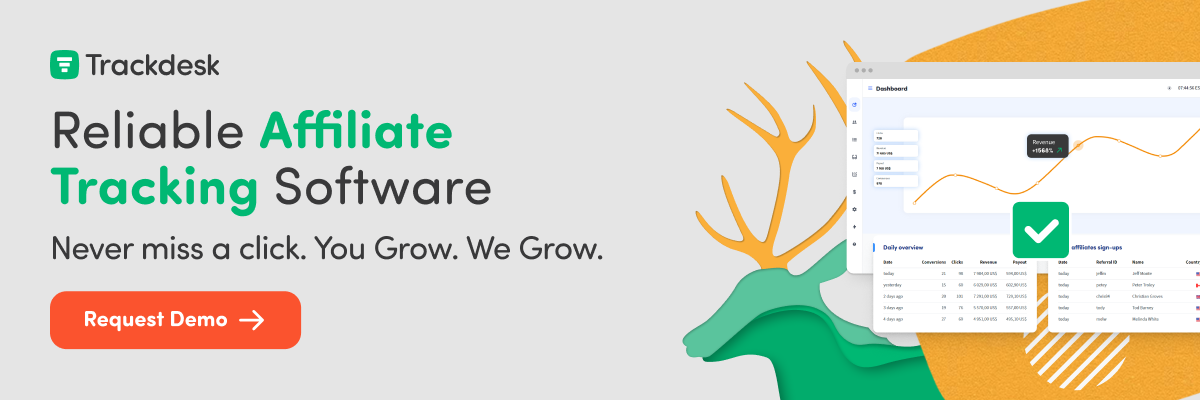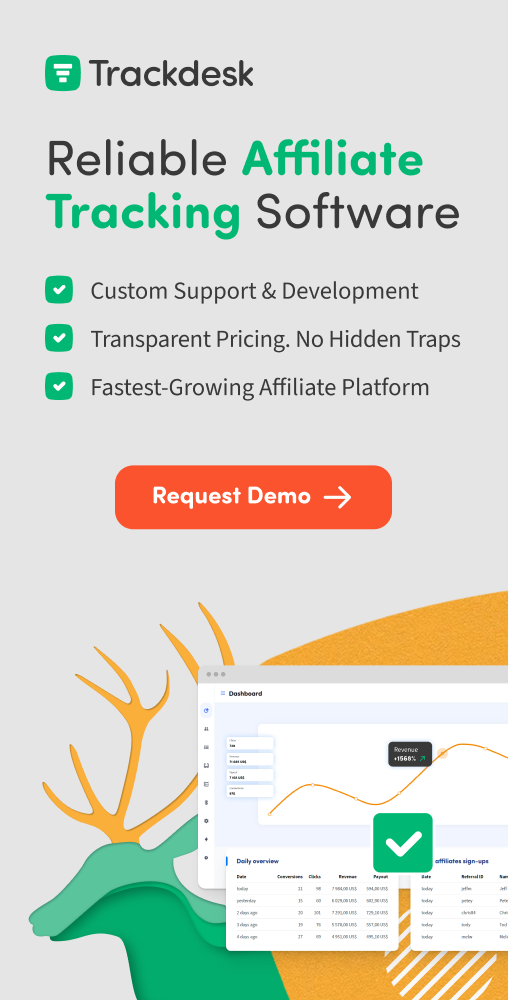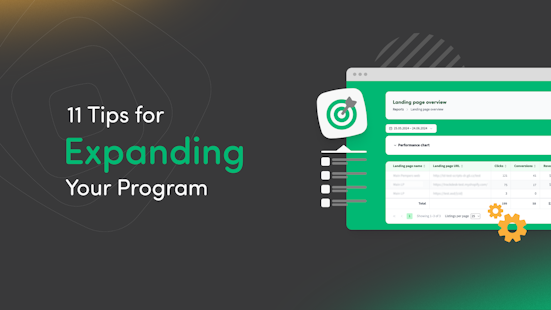
Master Affiliate Management: 11 Tips for Your Program Growth
Let's go through 11 proven tips to improve your affiliate management from partner search to performance analysis.
Affiliate management helps boost your business reach and sales by partnering with individuals or organisations to promote your product or service on their platforms. With the aid of online tools, you can efficiently handle this partnership, from recruitment to communications, analytics, and payouts.
To leverage your partner's influence for website traffic, conversions, and revenue, you must implement strategies that will be beneficial to your relationship. This article will discuss how to manage affiliates so you can achieve your goals.
1. Find High-Quality Affiliates
Affiliates don't have to be familiar with your product or service. But they must be trustworthy entities within your target market and niche. Their values and influence should also match your business type and audience. Check out their online content to examine their credibility. Also, look for people or organisations that interact regularly with their online community or followers. Affiliates include:
-
Existing customers
Your current clients are already familiar with your product or service and may have already referred you to relatives and friends. Personally invite your best customers to join your affiliate program. Tell them about the commission they will receive whenever people purchase your products or avail of your services through their affiliate link.
-
Bloggers and social media influencers
Partnering with bloggers and influencers whose audiences overlap with yours can draw warm leads to your site. The volume of leads can be higher if you partner with people who aren't just content creators but also experts in their niche.
When you spot a blog or social media post mentioning your product, you can connect with the author or user and ask if they would be willing to add an affiliate link to your site. Also, reach out to bloggers or influencers who often discuss a list of "best" products or services similar to yours. Invite them to feature your product in exchange for a commission.
-
Non-competing sites
Distinguishing potential allies from rivals is a necessary skill when finding affiliates. You can collaborate with websites of businesses that offer different but complementary products or services, which will benefit your target market. They include the following:
- Coupon sites - offer discounts that make it easier for subscribers to purchase. Examples include RetailMeNot, Coupons.com, Rakuten, Groupon, Brad's Deals, Honey, and Slickdeals. You can also claim cashback on some of these sites.
- Loyalty and cashback sites – where subscribers make purchases to earn cashback and rewards. Examples include Ibotta, Fetch, and Capital One Shopping.
-
Individuals from affiliate networks
A quick way to find affiliate program partners is to join open affiliate marketplaces, also known as affiliate networks. You can list your product or service on this platform and wait for affiliates to find you. Unlike running a private network using affiliate software, these marketplaces handle your affiliate program management—including program promotions, sales tracking, and payment processing. But they charge various fees, such as a joining fee, a "finder's fee," and a commission when your affiliate makes a sale. The platform owns your affiliate relationships and tracking data. You'll also have to actively compete for partners with other businesses registered on that network.
2. Build Good Relationships with Affiliates
The road to a meaningful, long-term partnership with new affiliates starts with onboarding and helping them make their first sale. This includes creating step-by-step guides to help new affiliates better understand your products and services and how they work. The consecutive processes introduce new partners to your affiliate program so they can promote your brand effectively.
Here are onboarding steps that will help you attract and retain affiliates:
-
Customise your sign-up or landing page.
Think about all the data you require from new affiliates and ask them to provide it through your signup forms or landing page. When crafted thoughtfully, this page can motivate them to complete the registration. It must share a bit about your brand—specifically, the affiliate terms of use and the benefits of joining your affiliate program. Furthermore, it should concisely seek only relevant information, primarily their contact information (email and social media handles) and the channels where they plan to promote.
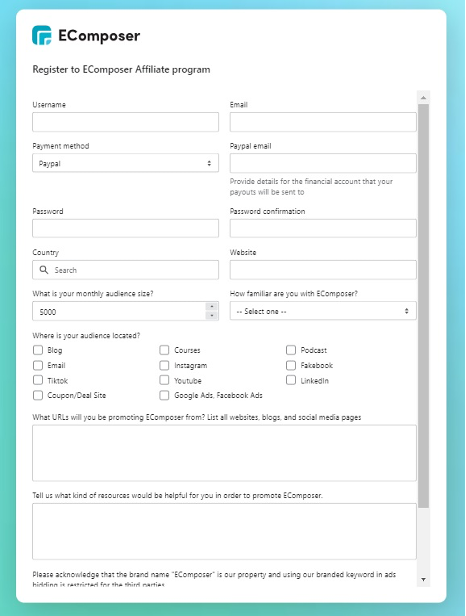
-
Give a personalised welcome.
Make your new partners feel welcome to your team by sending emails once they qualify or agree to join as affiliates. Invite them to relevant groups on Facebook, Slack, or other forums. Such social proof further strengthens trust and motivation.
Here's a sample template suggested by Post Affiliate Pro:
Hey [name],
It’s really exciting to see that you’ve joined www.postaffiliatepro.com/. Post Affiliate Pro is highly recommended by users for its exceptional support and user-friendly affiliate marketing software. The live chat and phone support are available 24/7 and the team is skilled, patient, and thorough. The software fulfils every wish and provides all the key functionality needed for successful affiliate management!
We’re sure that you’ll really enjoy promoting [product/service that the affiliate will promote].
To make the onboarding smooth and easy, we’ve gathered a few links that you may find useful:
First steps as an affiliate at [company]
Terms and conditions of [affiliate program name]
[affiliate program name] Knowledge Base
If you need anything else, remember that you can always reach out to us!
Best,
The [affiliate program name] Team
Orient them clearly on your program details.
Let's face it. Your new affiliates will probably not read your terms and conditions carefully. Review the agreement with them again to clarify expectations. Prepare a "getting started" guide that will cover the following details:
- Brand/company overview
- Commission rates
- Payout schedule and methods
- Terms of your program
- Affiliate's primary responsibilities and duties
- Affiliate tools
- Branded materials
- Who to contact for questions and problems
- Incentives, bonuses, and how to earn them
With time, you can enhance your welcome and orientation sessions by segmenting your affiliates. You can consider grouping them according to:
- Level of experience with your product or service (new versus long-time users)
- Level of experience with affiliate marketing (new versus long-time bloggers or influencers)
- Their audience size (micro versus macro influencers)
- Their platforms (social media, blog, or email)
-
Set up communication channels.
Provide a dedicated email address for receiving marketing materials and include them in your team chat for quick reminders and urgent messages. While email remains the primary channel, some affiliates prefer using messaging apps for faster responses. If you choose to use iMessage for quick check-ins with certain affiliates, have a backup plan in place in cases of iMessage not working.
-
Give access to marketing materials and insights.
Provide affiliates with resources, such as:
- Image banners/product images
- Product descriptions
- Facebook posts, Tweets, YouTube/Vimeo videos
- Text links
- Discount or promo codes
You can also pass on insights and other information to help them acquire customers, including:
- Your prospects’ favourite social platforms
- Topics they want more of
- Keywords prospects search for
- Other brands/competitors your prospects are considering
As part of your pledge to ensure ongoing improvement to your affiliate program management, tailor-fit the onboarding experience to your affiliates by considering the following:
- Their top skills, strengths, and weaknesses
- Their preferred training method, pacing, and frequency of check-ins
- What would help them get comfortable with their responsibilities
- The information or tools they need the most
- The incentives that work best for them
How to Support Your Affiliates with Their First Sale
Although product knowledge is vital, your affiliates will find it easier to relate to your sales approach first. You can use illustrations and diagrams to make the process easier to grasp. Show them how to align their marketing style with your brand’s voice and tone. When possible, create a personalised affiliate landing page featuring your logo and your affiliate’s trademark.
The EComposer affiliate program signup page could be customised to suit that look of an affiliate's website.
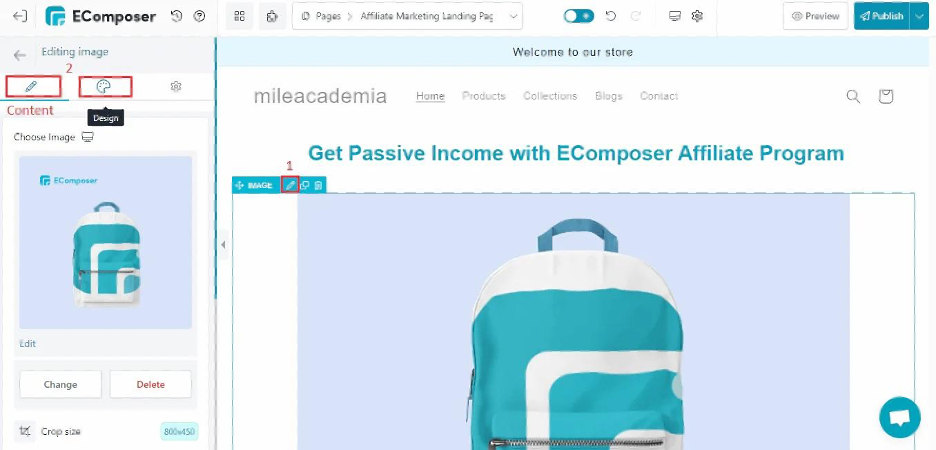
After discussing your sales approach, share your ideal customer profile to give them a deeper understanding of your market. Identify the products/services that convert well for each market segment. Moreover, tell them what product information fits in each stage of a buyer's journey.
Remember to inspire your affiliates by sharing the strategies used by your new partners to bag their first sale. Stay open to suggestions—even when co-creating content. However, you can be firm about your standards. Provide constructive feedback, always acknowledging or praising their contributions.
3. Set Attractive Commission Rates and Incentives
Competitive commission rates and exclusive incentives don't only attract quality affiliates. These affiliate deals also motivate partners to aim for high-value sales or to prioritise your brand if they belong to multiple affiliate programs.
Commissions
You can design your commission structure based on product type, affiliate performance, and market trends, including client acquisition and operating costs (such as fulfilment or shipping fees). Some brands (particularly SaaS companies) offer recurring or flat commissions as long as their referrals maintain their subscriptions. In such cases, integrating a reliable SaaS billing platform can help automate and accurately track recurring payments and affiliate payouts, ensuring transparency and reducing administrative overhead.
Incentives
When selecting incentives, you must strike a balance between what motivates affiliates and what your business can afford to pay consistently. Set a realistic incentive budget by first accounting for your base commission rates. Then, determine if your incentives will be either fixed or performance-based.
-
Fixed rewards
Fixed rewards will be available to all affiliates once they meet certain conditions. For example, you can send partners free products as part of their welcome package, after hitting a sales milestone, or upon reaching their affiliate anniversary. You can send two pieces of a product to an affiliate so they can give the other item to a family member or friend they can refer to your program.
Other fixed rewards include deep discounts that allow affiliates to buy multiple (premium-priced) products. Or you can offer store credits of varying amounts, issuing them strategically. For example, you can set special credits for "joining" your program, reaching specific sales targets, and being the month's top performer.
-
Performance-based rewards
Meanwhile, performance-based rewards—which you will base on sales goals reached—increase promotional efforts and recognise top performers. You can also create a "limited-time" incentive for campaigns you'll run for short periods to build a sense of urgency. Coincide temporary bonuses during seasonal sales (summer or winter), major shopping holidays (Black Friday, back-to-school), slow sales periods, or new product launches.
Besides considering your budget and growth, look into your competitors' incentives, so your offer is at least on par with the industry if you can't enhance it.
4. Invest in Affiliate Tracking Software
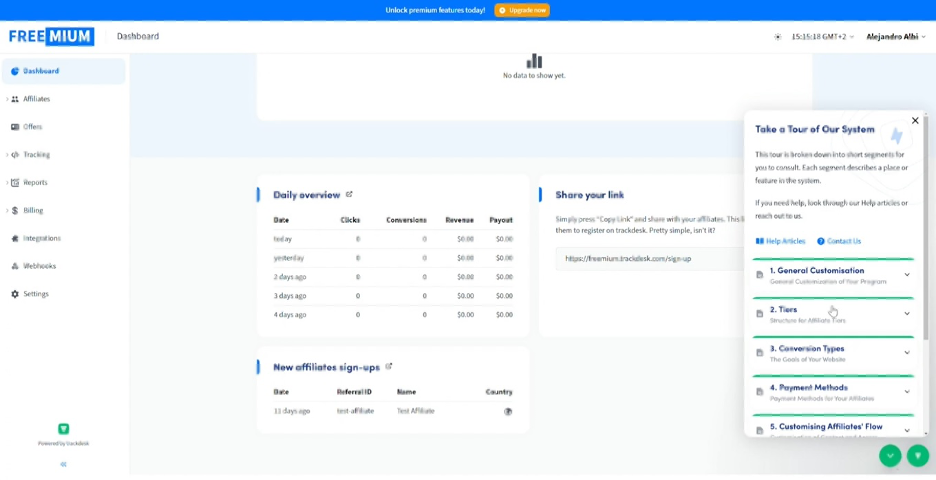
Trackdesk dashboard: Source (0:53)
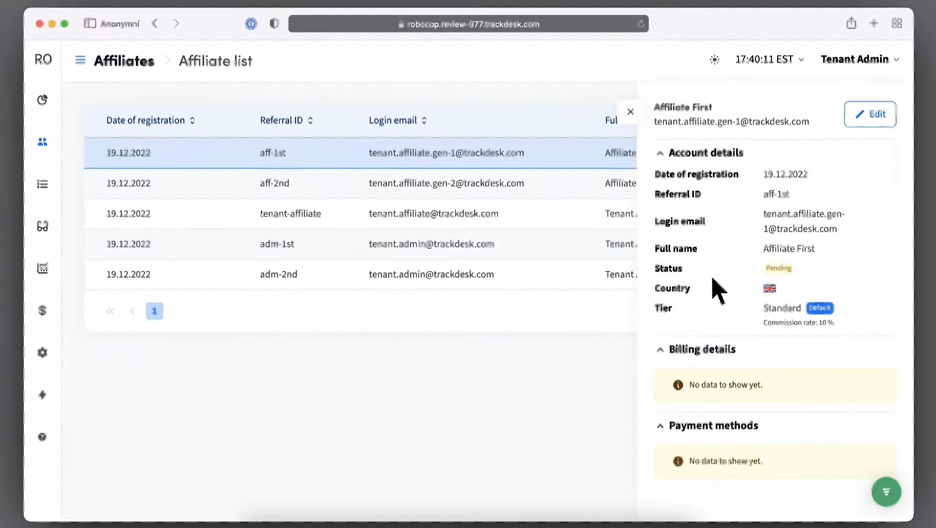
Trackdesk dashboard: Source (0:20)
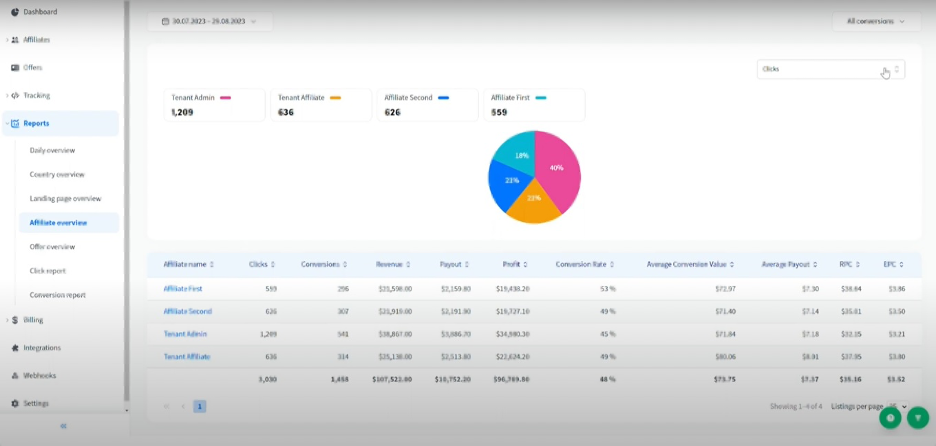
Trackdesk dashboard: Source (17:17)
An affiliate tracking software allows you to organise and save information about your affiliates, communicate with them, and monitor their sales performance. When selecting an affiliate program management solution, consider the following features:
-
Integration
Ensure that the software is compatible with your customer relationship management system (preferably the affiliate solution has one built-in), and the rest of your tech stack. This integration provides a full view of your affiliates' impact on revenue growth, allowing you to make data-backed marketing decisions.
-
Reporting
Choose a tool that displays relevant metrics for each affiliate, including their sales and clicks and the purchase conversion rate of their traffic. This feature quickly identifies your top affiliate partners and indicates the effectiveness of your rewards model.
-
Customisation
Find a solution that gives you the flexibility to set your commission structure—including pay per click, pay per lead, pay per sale, and branding.
-
Fraud detection
Choose a tool that can detect marketing partners who send spam traffic and make fake orders to earn commissions.
-
Mobile compatibility
With the best affiliate tracking software, you can manage your affiliate program on the go, while allowing your partners to conveniently access their dashboards anytime, anywhere.
-
Payout options
Rewards tracking and easy payment systems assure affiliates they can receive their commission and other incentives accurately and quickly.
Trackdesk can help you kickstart your affiliate program with zero upfront costs. All features are free to use until you generate $5,000 worth of monthly affiliate revenue. You can check out our comparison page, which shows you why we're the best solution in the market. The free plan offers integrations with Stripe, Zapier, Shopify, WooCommerce, and 100+ tools.
5. Measure Results Daily
Keeping your affiliate management on track involves measuring, tracking, and optimising your campaigns and partners’ performance daily, but you must first clarify your goals (increase traffic, average order value, or conversion rates year-on-year) to determine the metrics or key performance indicators (KPIs) for monitoring affiliate performance. The results help you determine how well your program is going and what you need to improve. You only spend time, money, and other resources making changes that drive growth.
A Referral Rock survey showed the most highly ranked KPIs among affiliate marketers:
- affiliate link clicks (83%)
- conversion rate (72%)
- total purchases through affiliate links (62%)
- total revenue from affiliates (59%)
- earnings per click (41%)
- return on investment (38%)
- customer lifetime value (38%)
- revenue growth (34%)
- number or percentage of new clients acquired through the affiliate program (34%)
6. Foster a Sense of Community
Retain more affiliates longer by providing opportunities for them to interact among themselves. At the same time, show how much you value them through loyalty-building efforts.
Encourage interaction
Create accounts in social media or forums where affiliates can exchange experiences, best practices, and ideas. You can also leverage collaboration software to facilitate communication, enabling affiliates to easily connect and share valuable updates. Spending time with others who share the same mission can give affiliates a higher sense of purpose.
Build loyalty
You can earn your affiliates' loyalty when they feel you're invested in their growth and care about their success. Engage with them periodically, updating them via:
- Emails
- One-on-one and group sessions to address questions, challenges, and concerns
- Newsletters
- New marketing materials showing product updates
- Reports on revenue or milestones reached as a result of affiliate payments
- Ongoing training
Remember to congratulate affiliates after they earn their first sale or incentive. Moreover, recognise them for hitting or exceeding targets. Give away badges or other physical symbols to acknowledge their progress and hard work.
7. Conduct Regular Compliance Reviews
Auditing affiliate activities regularly ensures that they operate according to your affiliate marketing agreement. You can establish a compliance program, which lists steps for investigating and resolving complaints, imposing penalties for violations, and, if necessary, terminating affiliate relationships.
With the aid of your affiliate management tool's analytics, watch out for these scams:
- Unusual patterns: sudden surge in clicks or conversions (resulting from the use of malware, mobile apps, and websites to artificially inflate click-through rates or the creation of fake customer accounts to generate more leads)
- Using unauthorised materials: unapproved use of your logo/other business trademarks or brand keywords in paid search campaigns (brand bidding), "typosquatting" or registering a domain name very similar to yours), and spamming practices (unsolicited emails, comments, and messages to promote affiliate links)
- Irregular payment requests and inability to provide complete documentation required for receiving payouts
- Commission theft: stealing commissions by replacing a fellow affiliate's ID with their own or by URL hijacking the affiliate partner’s browser session
Besides using your affiliate platform's fraud detection feature, you can protect yourself from fraud with these steps:
-
Validate leads and sales
Verify the legitimacy of transactions before releasing commissions. Besides creating fake buyer accounts, affiliates may use stolen credit card data to secure commissions.
-
Include the right to delay or withhold payout in your agreement
You can include this in your affiliate contract to give room for possible refunds and chargebacks. Or you can set commission eligibility levels for earning payments to discourage producing excessive but low-quality leads in exchange for quick rewards.
8. Know Your Budget and Limitations
When running an affiliate program, begin with an offer within the lowest range in your industry. You can eventually increase the amount as you get more experience and earn more revenue.
Your affiliate management budget must factor in:
- Website costs
- Affiliate management tool subscription or affiliate network membership
- Marketing materials
- Your chosen vertical
- Your types of offers
- Your competition
You can launch an affiliate marketing program at below $100 for your domain registration and hosting fees. However, you can also bootstrap your way through the process at no upfront costs by finding and connecting with affiliates on social media and by email. Harnessing user-generated content can also take the place of ad creatives. Give yourself four months to a year to start seeing your first sales. A financial forecasting tool can help you estimate performance and manage your affiliate budget with greater confidence as you grow.
9. Plan Ahead: Use a Promotional Calendar
Create a content calendar so you can schedule the dates for offering exclusive deals or bonuses for your partners. You can also share the calendar so you and your affiliates are on the same page when announcing promotions, product launches, and holiday offers. A year-long list of events can spark ideas for your partners and make it easier to generate targeted content in advance. Here are examples from Commission Factory and Printify.
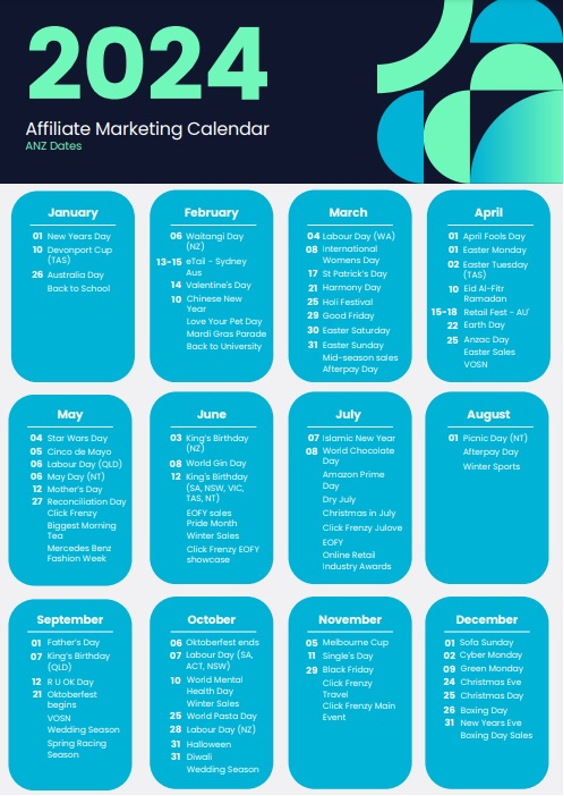
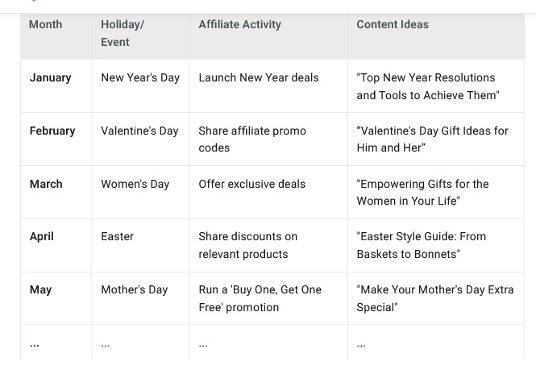
10. Stay on Top of Industry Trends
Ensure your campaigns are still effective by researching and comparing yours with the activities of other players in your industry. Keeping pace with trends also helps you discover any new marketing techniques and advertising regulations.
Update your team promptly when you change policies, commission rates, or offers due to market trends. Also, regularly refresh your affiliate orientation content to include the latest developments in your niche or industry.
11. Strike a Balance Between Patience and Diligence
Growing your affiliate program requires due diligence and persistence. However, remember that growth requires time after the vetting process and amid consistent monitoring. Affiliates equipped with tools, marketing materials, and organisational support—not red tape or seemingly endless approvals—gain the confidence to pick up speed autonomously. You must also rally them to see short and long-term trends and align campaigns accordingly.
Final Thoughts
Mastering affiliate management is a life-long process. Although aspects of your program may eventually evolve, the 11 steps above can help you weather challenges brought by economic, regulatory, and technological changes. A successful affiliate program all starts with wise partner selection. Honest, solutions-oriented, and collaborative partners can attract consumers to your brand and boost sales. It pays to stay wary of competitors and their negative effects on operations through regular team communication, performance tracking, and fraud monitoring.
Trackdesk has onboarding features affiliates love, whether you're into SaaS, E-commerce, prop trading, or influencer marketing. Commission configurations and fraud protection are available across all paid plans. You also get full white labelling on Business and Enterprise plans. What’s more, you can keep abreast of affiliate marketing trends and tips through Trackdesk's Affiliate Academy.

I have a passion for storytelling. I believe that a good story delivers value while capturing, influencing, and sustaining its intended audience. This has always been, and always will be, my primary aim as a writer.
